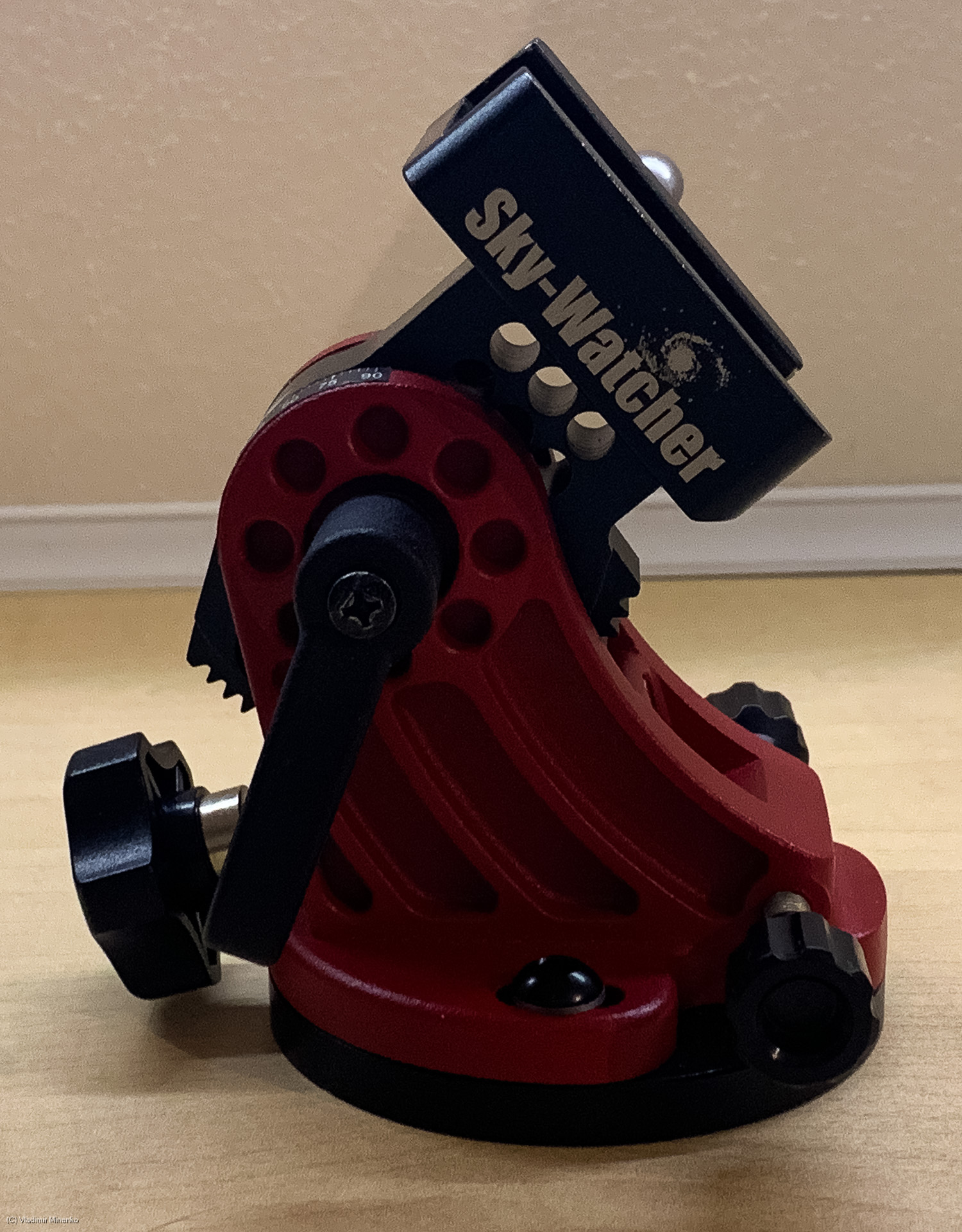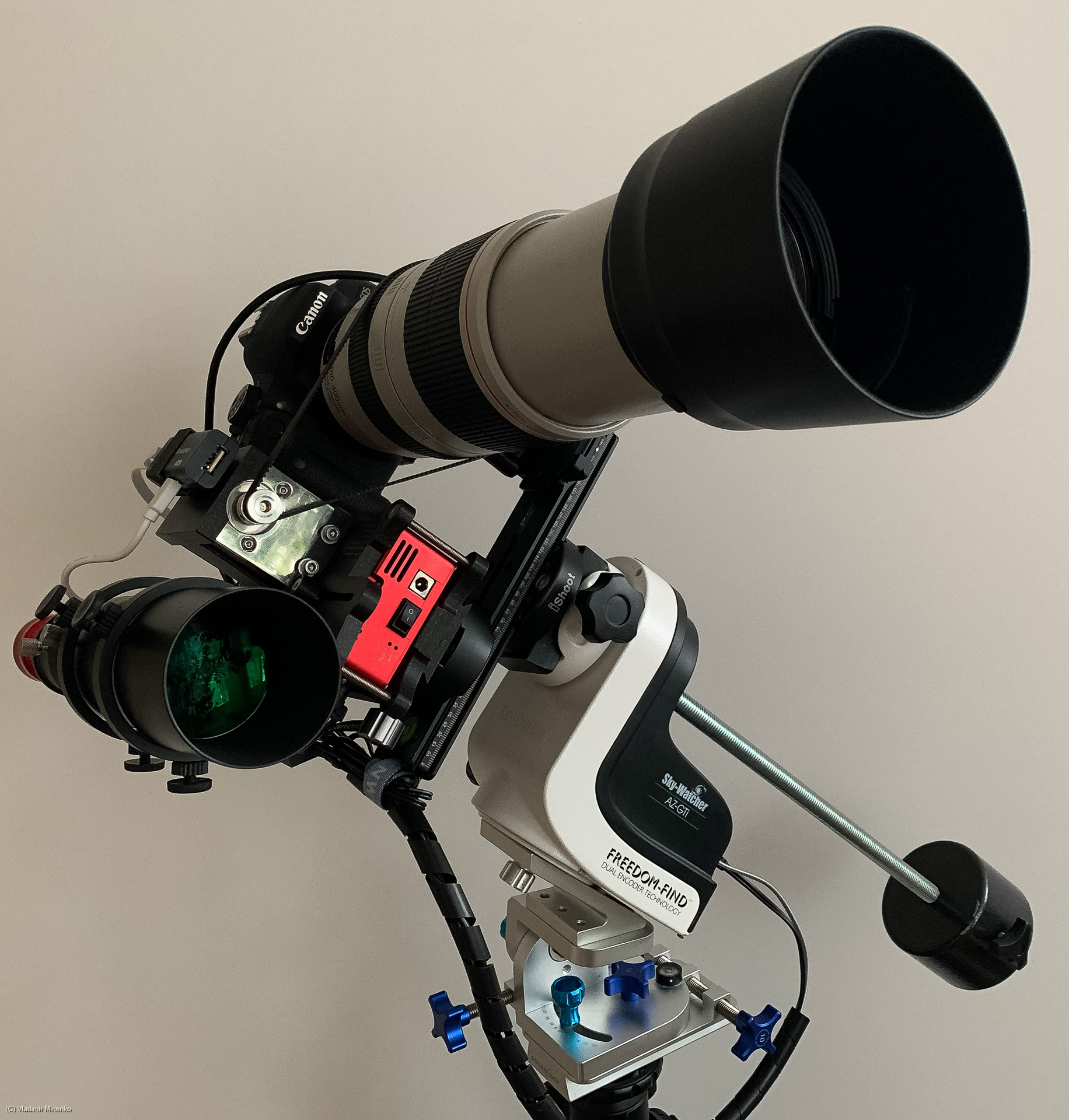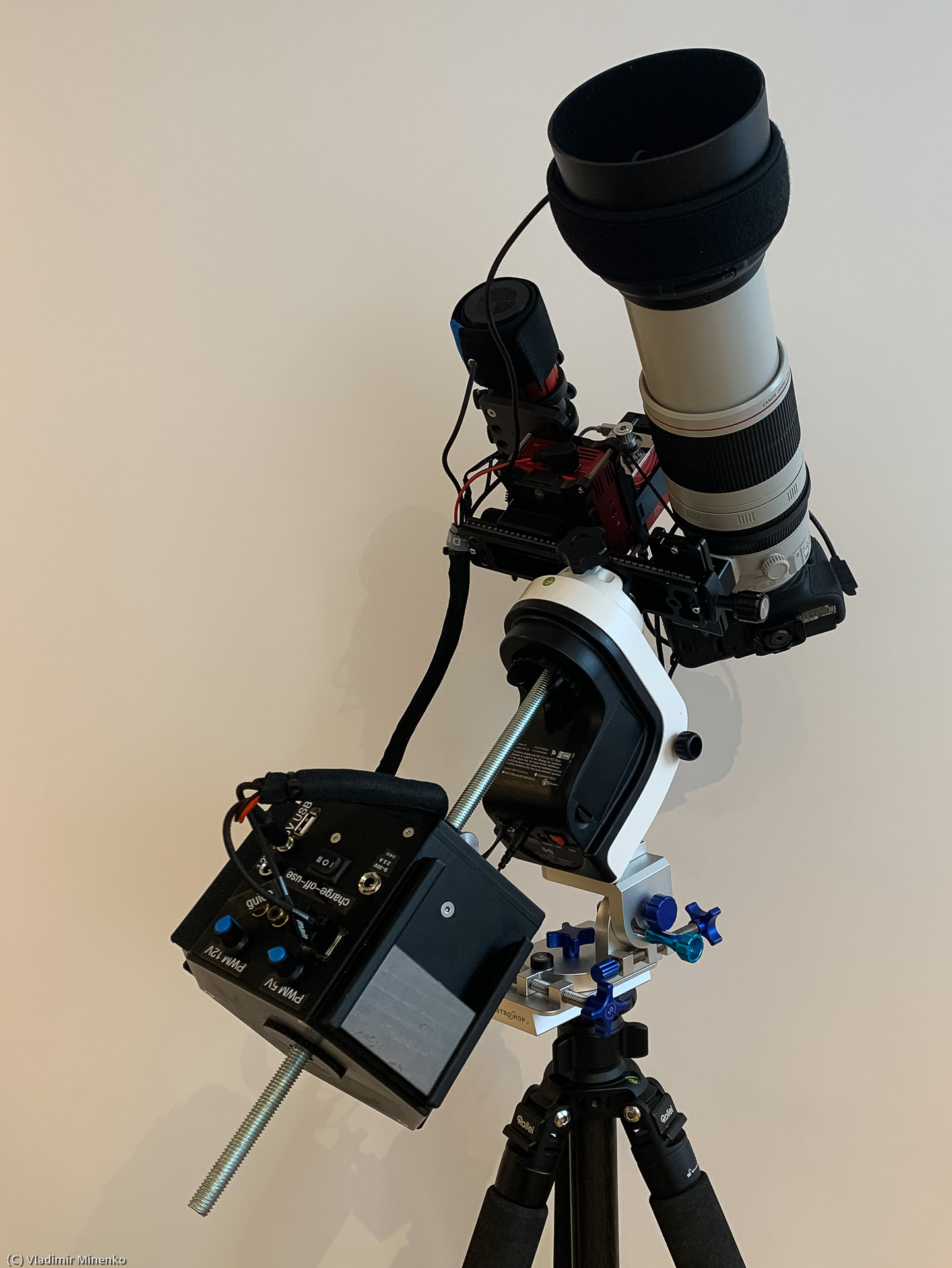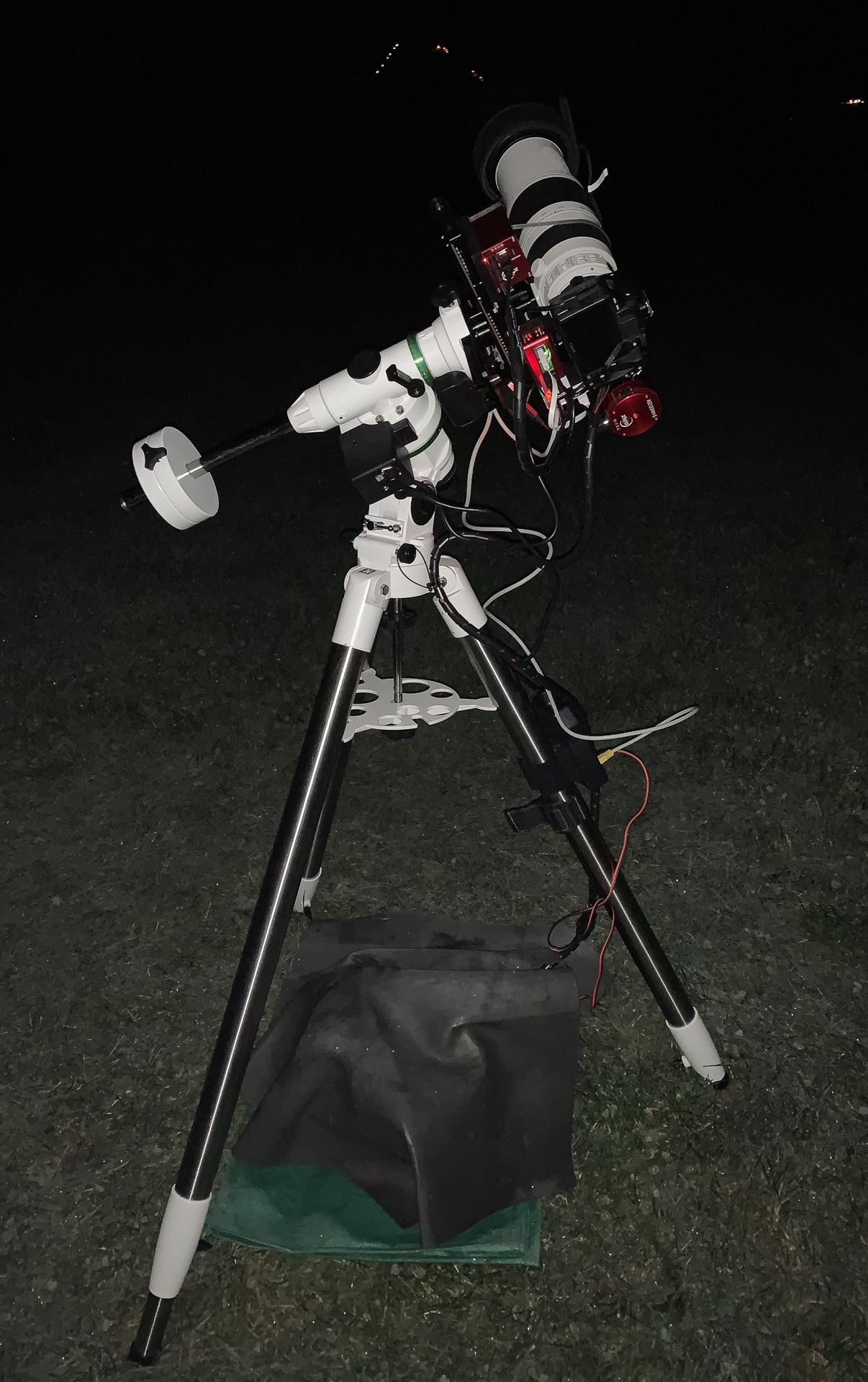From a Star Tracker to a Mount
Both do roughly the same, and you might end up using bothCompensation of the Earth Rotation
Star Trackers
Start Trackers have only one axis. They provide a motorized system rotating a camera holder on this axis in the opposite direction to the rotation of the Earth.
![]()
In order to put this axis in the right direction, an adjustable wedge base is requited. Make sure, such a wedge base is included. They are usually called “equatorial wedge” or “polar wedge”.

All Star Trackers are designed for a limited payload. It is usually in the range of 3-5kg. It is a good idea to not scratch the limits. Nothing really bad will happen otherwise, despite pure tracking results, lost time and disappointments. Some trackers allow attaching counterweights. Unless you have an very light camera with small lenses, I strongly advise to always use counterweights. Constant rotation can bring the tripod out of balance and it will fall over.
A star tracker usually has either an integrated small scope for polar alignment or a holder for such a scope. This scope is essential, since it helps to align the star tracker rotation axis with the axis of the Earth. Since this axis is not exactly pointing to the Polaris star in the Northern Hemisphere and to Sigma Octantis in the Southern Hemisphere, most these scopes have a reticle with markings. The reticle has to be back-lighted. Be aware that on some star trackers, the view through the this scope can be obscured by the attached camera. This is very unfortunate, since you can put your camera on the tacker only after you are done with the polar alignment. One wrong move in this, and you can start with polar alignment again. The minimal version of the Sky-Watcher Adventurer Mini is one of those. You need to get an additional L-formed bar to avoid this.
Altitude-Azimuth Mounts
Compared to a star tracker, mounts have two rotation axis. There are two most broadly used designs: alt-azimuth and equatorial mounts. Alt-azimuth mounts can move an attached scope in horizontal (“alt”, altitude angle) and vertical (azimuth angle) directions.
Alt-azimuth mounts (also know as “Alt-AZ mounts” or just “AZ mounts”) are mostly used in visual observations. They do not require any alignment at initial steps, only the current time and position. They cannot fully compensate Earth rotation which is important for astrophotography. “Fully” means there that is it possible to follow the movement of a star in the center of the field of view (FOV) with an alt-azimuth mount, but this field of view will rotate around the center during this follow move. This is not a problem in visual observations since the human eye does not perceive this effect as disturbing if visible at all. For photography, the effect is crucial, since after stacking of multiple images, all parts of the image close to the edges seem to rotate around the center.
A vast majority of people use equatorial mounts for astrophotography.
Equatorial Mounts
Compared to alt-azimuth mounts, one axis of equatorial mounts (also known as German Equatorial Mount, “GEM” or just “EQ” mounts) should be aligned along the axis of the Earth. The second axis rotates at the right angle to the first one. This setup is reflecting mechanics of the equatorial coordinate system and thus can follow celestial (astronomical) objects without distortions in the field of view (FOV). All this requires an alignment of an EQ mount the same way as of a star tracker. Compared to a star tracker, a mount (regardless, AZ or EQ) can move the FOV to any place in the sky by moving around their axis. Equipped with motors and a computerized controller, they can do a “go-to” by taking just coordinates and moving to this position. Today, almost all new mounts have motors and are provided at least with simple controllers.
Selecting a Star Tracker
A star tracker is a must-have piece of equipment and it will stay even after you by a real mount. It makes sense to get right stuff and not do not get tempted by low-price products and DIY-solutions, unless this is DIY is your another hobby. A star tracker will move several much more expensive parts and so can completely ruin a multi-hour session in the middle of the night, in the middle of nothing. This is not a place for low-budget solutions, IMHO.
Make sure you use a good tripod! “Good” means here “as steady as possible”. Its box should say, it can carry at least 10kg or more. You will not have this payload with a star tracker, but this number ensures some reserve in stiffness which you definitely need!
iOptron SkyGuider Pro and the Sky-Watcher Star Adventurer series are the most popular star trackers. And this for a reasons. They all do it right and have a reasonable price, around 300-450 Euro. iOptron SkyGuider Pro is also available with an integrated iPolar camera. Even though this camera costs extra 250 Euro, and requires a notebook for the alignment procedure, this extra is definitely worth it! See the dedicated page about computerized polar alignment.
I currently use the Sky-Watcher Star Adventurer Mini with original counterweight and the L-Bracket for the camera mounting:

A counterweight improves tracking and stability, but compared to my Sky-Watcher AZ GTI mount, it is less critical. The L-Bracket is a “must” though, since you otherwise have to mount the camera on a place where the polar scope is looking through. Due to this, you have to wait with mounting the camera until you finished the polar alignment via the polar scope. The whole setup as shown above but without the tripod weights only 3kg and can be taken on most trips.
If I would buy a star tracker today, I would get the iOptron SkyGuider Pro with integrated iPolar camera. This tracker cannot do timelapse and cannot be controlled by an app, but has integrated solution for polar alignment based on plate solving and carries up to 5kg payload.
The below links will lead you to a few detailed reviews of various star trackers:
- https://www.peterzelinka.com/blog/2018/8/which-star-tracker-should-i-get
- https://nacht-lichter.de/reisemontierungen (in German)
Reasons for an Upgrade to a Real Mount
Star trackers lack a few features by design. They do not provide any help to find objects in the sky, since their only task is compensate the Earth rotation. Yes, it is still possible with a manual search and you can find some how-to guides on the Internet. Doing this is not fun at all, not for me at least. Another drawback, that quite some star trackers do not support guiding, and if they do so, it is only on the one axis as there is only one. Guiding is needed starting at a focal length of 200mm and an exposure of 2min and longer. 2min is a comparably short exposure for most modern DRLS when used in Deep Sky astrophotography, it often much longer, especially when a filter is used. So you might sense a need to use guiding soon.
Both problems can be solved with a EQ equatorial mount supporting “Go-To”. Today, I would not consider a mount if it does not support automated “Go-To”. Around 20 years ago and earlier, people used knobs to move a mount by hand. First affordable motorized systems showed up around 2002 and supported tracking only. Go-To became affordable around 2006-2008. Modern mounts on the market today have a large number of improvements from the experience over years. Production quality improved a lot in the last five years as well. Still, mounts are in use for many many years for quite some people. As a beginner, I would not consider buying a used mount older than 3-4 years, unless your budget is extremely limited or know exactly what you are getting.
Generally, mounts are classified by the payload they can carry. Certainly, there are other important parameters, but payload is the major one. For some reasons, additional features features and better quality seem to be reserved for more powerful mounts. As a photographer you might be interested in a more compact and lightweight solution which can even be used on a regular tripod.
For my knowledge, The Sky-Watcher AZ GTI is one of very few products on the market now satisfying this criteria. The Sky-Watcher AZ GTI is not specified to carry more than 5kg payload.
I’m ok with this as my photo gear is around 3-3.5kg, even with Canon 5D Mark IV and a large telephoto lens.

The Sky-Watcher AZ GTI is also almost as portable as a large star tracker. The total weight the first version of the setup was slightly above 6kg excluding the main camera and the lens:

I meanwhile reduced the total weight by 1.5kg by combining the counterwieght and the battery:

If you are sure that astrophotography will last for longer, it might also sense invest in a larger and more steady mount, but then get a star tracker with a higher payload, like iOptron SkyGuider Pro. iOptron SkyGuider Pro can carry a higher payload and can be used with guiding for Deep Sky astrophotgraphy.
The next smallest and lightest mount would be Sky-Watcher EQM-35 with the total weight of 13kg including counterweights. This is around 3 times more than AZ GTI and might be not accepted for travel by your family 😉

Sky-Watcher EQM-35 has 3/8″ thread at the bottom, and from the total weight perspective might be still OK to be used on a photography tripod. Any larger, and in most cases a better mount will force you to use it with a propitiatory tripod coming with a mount. It is probably need, since most tripods for dailight photography are not made for such hight payloads and are not seady enough at this load.
The next mid-range budget-priced mount is Sky-Watcher HEQ5 Pro weights 30kg with counterweights. Mechanically, it can carry up to 14kg, but max 10kg are recommended for astrophotography. This kind of mount is still transportable by car. iOptron seems to make mounts with the best own-vs-payload weight ratio, at least on the specification. Compared to Sky-Watcher, they also have better mechanics, but they are not cheap. iOptron CEM45-EC or CEM40-EC would be an upgrade for Sky-Watcher AZ GTI, but they cost 3-4 times more than Sky-Watcher HEQ5 Pro and 2-3 times as much as Sky-Watcher EQ6-R Pro. Lostmandy is another maker of very good and also expensive mounts. All these mounts are known to work with ZWO ASIAIR directly, without a need for hand controller. This is a substantial difference in the workflow and is important for me.
On the bottom line, I would not advise to buy high-end mounts without a prior experience and a clear understanding on how and when you are going to use them. I found Sky-Watcher AZ GTI is an interesting alternative in the beginning. With its low weight and compact size, it can even serve as a star tracker with a Go-To capability. I will keep using it as a portable solution even if I would get a stronger mount in the future.
Mount Control Systems
Today, most mounts have a motor drive and support Go-To operations. This makes them consisting of two functional parts: the actual mount mechanics with a motor drive and a unit with a controller. The latter is also called “Hand Controller”. The motor drive unit has it own controller too, but its functionality is limited to controlling the motors. Meanwhile, most people in astrophotography seem to use either a PC or a specialized computer for all steps in the workflow. A hand controller is getting less relevant. The Sky-Watcher AZ GTI does not come with a hand controller. It is replaced by an app on a smartphone. Moreover when used with ZWO ASIAIR or Stellarmate via the EQmode cable (see the dedicated page about this), this app is not needed either. This is a very convenient way with much less clutter and parts which can go fail or become incompatible.
Unfortunately, a direct connection to the mount is not always possible and many mounts require connecting to their hand controller even though an external control would be possible in general. On top of this, there are no standard, cross-manufacturer communication protocols. You are better off to clarify the connectivity before buying a mount. I learned on my own experience, that as a beginner in astrophotography is it very essential to start with a simple setup and with less details you need to control. See my page about ASIAIR or Stellarmate as minimal clutter solutions.
0 Comments